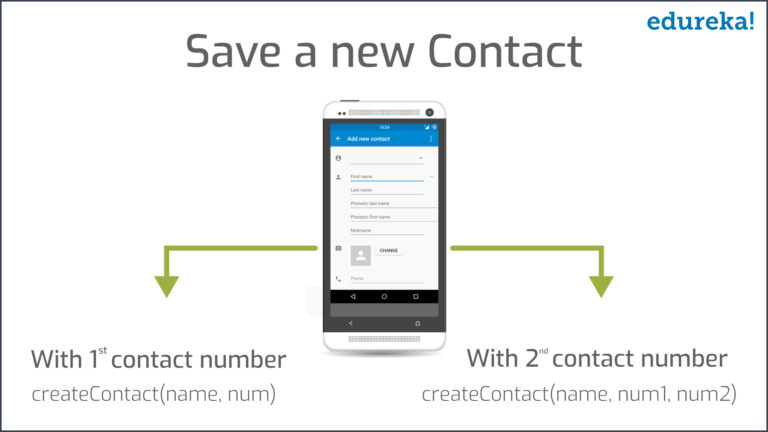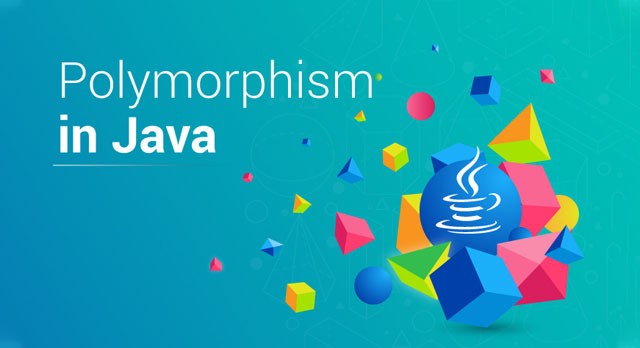This article on Polymorphism in Java talks about one of the key concepts of object oriented programming in depth.
In the real world, you might have seen a chameleon changing its color as per its requirement. If someone asks, “How it does that?”, you can simply say, “Because, it is polymorphic”. Similarly, in the programming world, Java objects possess the same functionality where each object can take multiple forms. This property is known as Polymorphism in Java, where Poly means many and morph means change (or ‘form’). In this article, let’s discuss this key concept of Object Oriented Programming i.e. Polymorphism in Java.
Below are the topics to be covered in this article:
- What is Polymorphism?
- Polymorphism in Java with Example
- Types of Polymorphism in Java
- Static Polymorphism
- Dynamic Polymorphism
- What is Polymorphism?
- Polymorphism in Java with Example
- Types of Polymorphism in Java
You can go through this OOPs concepts video lecture from where you can learn each & every nitty gritties of the technology.
What is Polymorphism?
Polymorphism is the ability of an entity to take several forms. In object-oriented programming, it refers to the ability of an object (or a reference to an object) to take different forms of objects. It allows a common data-gathering message to be sent to each class. Polymorphism encourages called as ‘extendibility’ which means an object or a class can have it’s uses extended.

In the above figure, you can see, Man is only one, but he takes multiple roles like — he is a dad to his child, he is an employee, a salesperson and many more. This is known as Polymorphism.
Now, let’s understand this by taking a real-life example and see how this concept fits into Object-oriented programming.
Polymorphism in Java with Example
Let’s understand this (the example) with the help of below problem statement.
Consider a cell phone where you save your Contacts. Suppose a person has two contact numbers. For the ease of accessibility, your cellphone provides you the functionality where you can save two numbers under the same name.
Similarly, in Java, an object is only one but it can take multiple forms depending on the context of the program. Suppose you want to write a function to save two contact numbers of the same person, you can create it like — void createContact(String name, int number1, int number2).
Now, it’s not necessary that everyone in your contact list will have two contact numbers. Few of them might be having only a single contact number. In such situations, instead of creating another method with a different name to save one number for a contact, what you can do is, create another method with the same name i.e. createContact(). But, instead of taking two contact numbers as parameters, take only one contact number as a parameter i.e. void createContact(String name, int number1).

As you can see in the above figure, createContact() method has two different definitions. Here, which definition is to be executed depends upon the number of parameters being passed. If one parameter is passed, then only a single contact number is saved under the contact. But, if two contact numbers are passed to this method at the same time, then both will be saved under the same contact. This is also known as Method Overloading*.*
Now let’s take another example and understand polymorphism in depth.
Consider a cell phone where you save your Contacts. Suppose a person has two contact numbers. For the ease of accessibility, your cellphone provides you the functionality where you can save two numbers under the same name.
Now relating this concept to an object-oriented language like Java, suppose you have a class named XJeans which includes a method named jeans(). Using this method, you can get an Allen Solly jeans. For the Jeans in the neighboring town, there is another class YJeans. Both the classes XJeans and YJeans extends the parent class ABCShoppingCenter. The YJeans class includes a method named jeans(), using which you can get both the jeans variants.
classABCShoppingCenter {
public void jeans() {
System.out.println("Default AllenSolly Jeans");
}
}
class XJeans extends ABCShoppingCenter {
public void jeans() {
System.out.println("Default AllenSolly Jeans");
}
}
class YJeans extends ABCShoppingCenter {
// This is overridden method
public void jeans() {
System.out.println("New variant of AllenSolly");
}
}
So, instead of creating different methods for every new variant, we can have a single method jeans**()**, which can be defined as per the different child classes. Thus, the method named jeans() has two definitions — one with only default jeans and other with both, the default jeans and the new variant. Now, which method gets invoked will depend on the type of object it belongs to. If you create ABCShoppingCenter class object, then there will be only one jeans available. But if you create YJeans class object, that extends ABCShoppingCenter class, then you can have both the variants. This is also known as Method Overriding*.* Thus, Polymorphism increases the simplicity and readability of the code by reducing the complexity. This makes Polymorphism in Java a very useful concept and it can be applied in real-world scenarios as well.
I hope you got an idea on the concept of Polymorphism. Now, let’s move further with this article and understand different types of Polymorphism in Java.
Types of Polymorphism in Java
Java supports two types of polymorphism and they are as follows:
- What is Polymorphism?
- Polymorphism in Java with Example
- Types of Polymorphism in Java
Static Polymorphism
A polymorphism that is resolved during compile time is known as static polymorphism. Method overloading is an example of compile time polymorphism.
Example
Method Overloading is a feature that allows a class to have two or more method to have the same name, but with different parameter lists. In the below example, you have two definitions of the same method add(). So, which add() method would be called is determined by the parameter list at the compile time. That is the reason this is also known as compile time polymorphism.
class Calculator
{
int add(int x, int y)
{
return x+y;
}
int add(int x, int y, int z)
{
return x+y+z;
}
}
public class Test
{
public static void main(String args[])
{
Calculator obj = new Calculator();
System.out.println(obj.add(100, 200));
System.out.println(obj.add(100, 200, 300));
}
}
This is how Static Polymorphism works. Now, let’s understand what is Dynamic Polymorphism in Java.
Dynamic Polymorphism
Dynamic polymorphism is a process in which a call to an overridden method is resolved at runtime, that’s why it is called runtime polymorphism. Method Overriding is one of the ways to achieve Dynamic Polymorphism. In any object-oriented programming language, Overriding is a feature that allows a subclass or child class to provide a specific implementation of a method that is already provided by one of its super-classes or parent classes.
Example
In the below example, you have two classes MacBook and iPad. MacBook is a parent class and iPad is a child class. The child class is overriding the method myMethod() of the parent class. Here, I have assigned child class object to the parent class reference to determine which method would be called at run-time. It is the type of object that determines which version of the method would be called (not the type of reference).
class MacBook{
public void myMethod(){
System.out.println("Overridden Method");
}
}
public class iPad extends MacBook{
public void myMethod(){
System.out.println("Overriding Method");
}
public static void main(String args[]){
MacBook obj = new iPad();
obj.myMethod();
}
}
Output:
Overriding Method
When you invoke the overriding method, then the object determines which method is to be executed. Thus, this decision is made at the run time.
I have listed down few more overriding examples.
MacBook obj = new MacBook();
obj.myMethod();
// This would call the myMethod() of parent class MacBook
iPad obj = new iPad();
obj.myMethod();
// This would call the myMethod() of child class iPad
MacBook obj = new iPad();
obj.myMethod();
// This would call the myMethod() of child class iPad
In the third example, the method of the child class is to be executed because the method that needs to be executed is determined by the type of object. Since the object belongs to the child class, the child class version of myMethod() is called.
Advantages of Dynamic Polymorphism
- Static Polymorphism
- Dynamic Polymorphism
This was all about different types. Now let’s see some important other characteristics of Polymorphism.
Other Characteristics of Polymorphism in Java
In addition to these two main types of polymorphism in Java, there are other characteristics in the Java programming language that exhibits polymorphism like:
- What is Polymorphism?
- Polymorphism in Java with Example
- Types of Polymorphism in Java
Let’s discuss some of these characteristics.
Coercion
Polymorphic coercion deals with implicit type conversion done by the compiler to prevent type errors. A typical example is seen in an integer and string concatenation.
String str="string"=2;
Operator Overloading
An operator or method overloading refers to a polymorphic characteristic of same symbol or operator having different meanings (forms) depending on the context. For example, the plus symbol (+) is used for mathematical addition as well as String concatenation. In either case, only context (i.e. argument types) determines the interpretation of the symbol.
String str = "2" + 2;
int sum = 2 + 2;
System.out.println(" str = %s\n sum = %d\n", str, sum);
Output:
str = 22sum = 4
Polymorphic Parameters
Parametric polymorphism allows a name of a parameter or method in a class to be associated with different types. In the below example I have defined content as a String and later as an Integer:
public class TextFile extends GenericFile{
private String content;
public String setContentDelimiter(){
int content = 100;
this.content = this.content + content;
}
}
Note: Declaration of polymorphic parameters can lead to a problem known as variable hiding**.**
Here, the local declaration of a parameter always overrides the global declaration of another parameter with the same name. To solve this problem, it is often advisable to use global references such as this keyword to point to global variables within a local context.
With this, we come to an end on Polymorphism in Java article. Do look out for other articles and videos in the series which will help you understand various concepts of Java.
If you wish to check out more articles on the market’s most trending technologies like Artificial Intelligence, DevOps, Ethical Hacking, then you can refer to Edureka’s official site.
#java #oop
